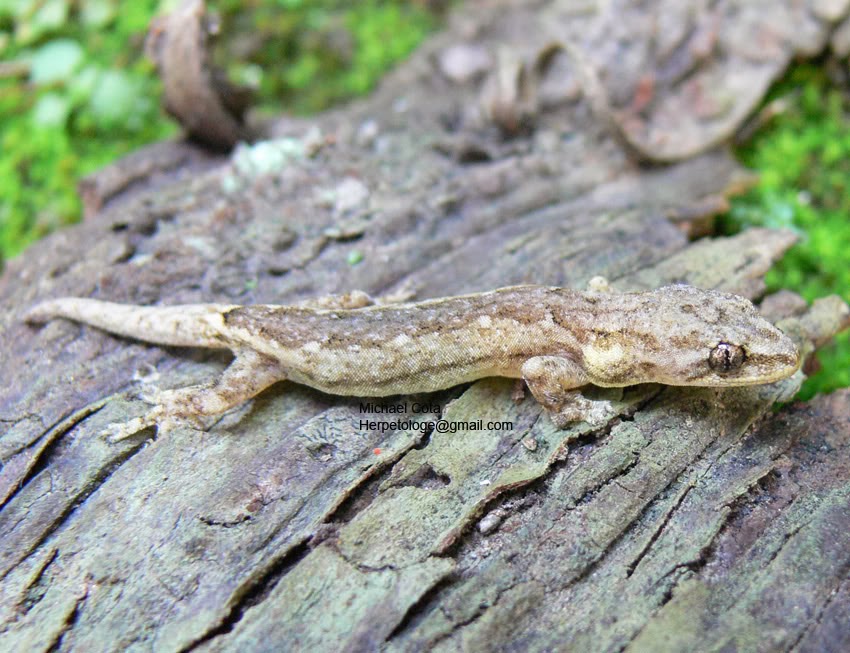[Most Recent Entries] [Calendar View]
Monday, February 21st, 2022
| Time | Event | ||||
| 8:23a | [Herpetology • 2014] Hemiphyllodactylus chiangmaiensis • A New Species of Hemiphyllodactylus Bleeker, 1860 (Squamata: Gekkonidae) from northwestern Thailand
Abstract A new species of gekkonid, Hemiphyllodactylus chiangmaiensis sp. nov., from northwestern Thailand is separated from all other species of Hemiphyllodactylus by a set of features including: a maximum SVL of 41.2 mm; 8–12 chin scales extending transversely from unions of second and third infralabials and posterior margin of mental; lamellar formula on hand 3–3–3–3 or 3–4–3–3; lamellar formula on foot 3–3–3–3 or 3–4–4–4; continuous precloacal and femoral pores; a unique dorsal color pattern; and caecum and oviducts pigmented. These characters place this species in the speciose H. typus group. Hemiphyllodactylus chiangmaiensis sp. nov. fills a biogeographical hiatus in the distribution of this genus across northern Indochina. Keywords: Gekkonidae, Hemiphyllodactylus, Hemiphyllodactylus chiangmaiensis sp. nov., Thailand, Chiang Mai, new species L. Lee Grismer, Perry L. Wood, Jr. and Michael Cota. 2014. A New Species of Hemiphyllodactylus Bleeker, 1860 (Squamata: Gekkonidae) from northwestern Thailand. Zootaxa. 3760(1): 067–078. DOI: 10.11646/zootaxa.3760.1.4 | ||||
| 3:06p | [Paleontology • 2022] Mambawakale ruhuhu • A New Pseudosuchian Archosaur (Pseudosuchia) from the Middle Triassic Manda Beds of Tanzania
Abstract The Manda Beds of southwest Tanzania have yielded key insights into the early evolutionary radiation of archosaurian reptiles. Many key archosaur specimens were collected from the Manda Beds in the 1930s and 1960s, but until recently, few of these had been formally published. Here, we describe an archosaur specimen collected in 1963 which has previously been referred to informally as Pallisteria angustimentum. We recognize this specimen as the type of a new taxon, Mambawakale ruhuhu gen. et sp. nov. The holotype and only known specimen of M. ruhuhu comprises a partial skull of large size (greater than 75 cm inferred length), lower jaws and fragments of the postcranium, including three anterior cervical vertebrae and a nearly complete left manus. Mambawakale ruhuhu is characterized by several cranial autapomorphies that allow it to be distinguished with confidence from all other Manda Beds archosaurs, with the possible exception of Stagonosuchus nyassicus for which comparisons are highly constrained due to very limited overlapping material. Phylogenetic analysis suggests that M. ruhuhu is an early diverging pseudosuchian, but more precise resolution is hampered by missing data. Mambawakale ruhuhu is one of the largest known pseudosuchians recovered to date from the Middle Triassic. Keywords: phylogeny, Pseudosuchia, Triassic, Archosauria, Tanzania
Systematic Palaeontology Archosauria 1869–1870 Pseudosuchia 1887–1890 Mambawakale ruhuhu gen. et sp. nov. Holotype. NHMUK R36620, partial skull including premaxillae, maxillae, vomers, palatines, pterygoids, ectopterygoids and fragments of the jugals and basipterygoid, with associated hemimandibles, hyoids and isolated maxillary or dentary teeth. These cranial remains are associated (see below) with an incomplete postcranium, including an atlantal intercentrum, partial axis and partial third cervical vertebra, a mostly complete left manus, and additional poorly preserved fragments. Etymology. Mambawakale, from the Kiswahili words mamba, meaning crocodile, and wakale, meaning ancient. The species name refers to the Ruhuhu Basin from which the type specimen and other taxa from the Manda Beds were collected. Locality and stratigraphy. Field locality U15/1 of Attridge et al. [1964], Lifua Member of the Manda Beds (Middle Triassic: ?Anisian), Ruhuhu Basin, southwest Tanzania. ... Richard J. Butler, Vincent Fernandez, Sterling J. Nesbitt, João Vasco Leite and David J. Gower. 2022. A New Pseudosuchian Archosaur, Mambawakale ruhuhu gen. et sp. nov., from the Middle Triassic Manda Beds of Tanzania. Royal Society Open Science. 9: 211622. DOI: 10.1098/rsos.211622 | ||||
| 3:35p | [Botany • 2022] Vaccinium carmesinum (Ericaceae: Vaccinieae) • A New Species of Blueberry from Mt. Tago Range, Mindanao Island, Philippines
Abstract Vaccinium carmesinum is described as a new species of Ericaceae from Mt. Tago Range, Mindanao Island, Philippines. It is similar to V. platyphyllum Merrill and V. luzoniense S.Vidal but is distinct from the former by longer and wider leaves, longer racemes, longer bracts, glabrous corollas, and glabrescent fruits, and from the latter by longer petioles, leaf glands distributed along the blade margin, glabrous rachis, and lanate filaments. Vaccinium carmesinum bears the widest leaves among Philippine Vaccinium. Its discovery increases the number of Vaccinium species recognized in the Philippines to 37. Key words: Mindanao, Pantaron Mountain Range, Vaccinieae, volcanic-igneous Vaccinium carmesinum M.N.Tamayo & P.W.Fritsch, sp. nov. Diagnosis:—Vaccinium carmesinum resembles V. platyphyllum Merrill (1917: 294) and V. luzoniense S.Vidal (1886: 168), but differs from the former by longer and wider leaves, longer racemes, longer bracts, glabrous corollas, and glabrescent fruits, and from the latter by longer petioles, leaf glands distributed along the length of the blade margin, a glabrous inflorescence rachis, and lanate filaments. Distribution and Habitat:—Vaccinium carmesinum is endemic to two mountains (Mt. Kiamo and Mt. Limbawon) in Mt. Tago Range, Mindanao, growing in tropical lower montane rainforest to upper montane rainforest. Populations of V. carmesinum were mostly found near summits where they thrive on volcanic-igneous or clay substrate with abundant humus. They also occur in areas of open shaded mossy forests, or on ridges covered in heathland scrub. Paratypes of the new species were collected on ca. 10–30% west-facing slopes. Etymology:—The epithet carmesinum is derived from the Greek word for crimson (blood red), as depicted by its crimson red petioles, floral bracts, peduncle, rachis, pedicels, hypanthium, and calyces. Moreover, a crimson red stain is extracted in notable quantity when the plants are soaked in a denatured alcohol solution. Maverick N. Tamayo, Fulgent P. Coritico, Victor B. Amoroso, Darin S. Penneys, Danilo N. Tandang and Peter W. Fritsch. 2022. Vaccinium carmesinum (Ericaceae), A New Species of Blueberry from Mt. Tago Range, Mindanao Island, Philippines. Phytotaxa. 533(3); 173-180. DOI: 10.11646/phytotaxa.533.3.3 |
| << Previous Day |
2022/02/21 [Calendar] |
Next Day >> |












